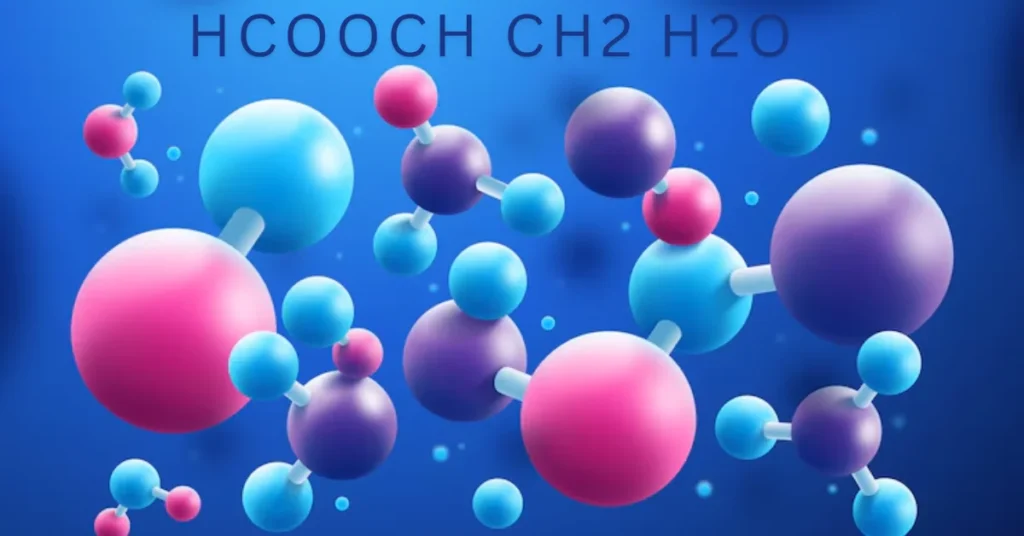Introduction: What is Hcooch Ch2 H2o?
Hcooch Ch2 H2o might appear as just another chemical formula, but this versatile compound holds significant value in both academic research and industrial applications. With its distinctive structure and multifunctional properties, it plays a crucial role in organic synthesis and various industries including pharmaceuticals, agriculture, and polymer chemistry.
In this article, we explore:
- The structure and function of Hcooch Ch2 H2o
- Its importance in synthetic chemistry
- Industrial applications
- Safety and handling tips
- Alternative compounds
- Future advancements and prospects
Understanding the Structure and Properties of Hcooch Ch2 H2o
Hcooch Ch2 H2o is an intriguing compound that consists of a methoxy group and an ethylene glycol component, which contributes to its notable chemical behavior.
Key Properties:
- High solubility and reactivity: Enables use as a solvent and reagent.
- Multifunctional utility: Supports complex molecular synthesis.
- Appealing for research: Opens avenues for innovations in pharmaceuticals and material sciences.
Its unique molecular setup makes it a valuable tool in developing new organic compounds and improving synthesis efficiency.
Importance in Organic Synthesis
Hcooch Ch2 H2o is a key player in organic chemistry, primarily due to its adaptability in various synthetic pathways.
Why It’s Important:
- Facilitates ester and amide formation, which are critical in pharmaceuticals and agrochemicals.
- Hydroxyl groups boost its reactivity in nucleophilic substitutions and additions.
- Supports green chemistry by offering an eco-friendly alternative for certain reactions.
Applications in Synthesis:
- Used as both a reagent and a solvent.
- Involved in stepwise synthesis of complex molecules.
- Contributes to environmentally conscious research methods.
Industrial Applications of Hcooch Ch2 H2o
This compound’s adaptability goes far beyond the lab bench, finding utility in numerous industrial sectors.
1. Pharmaceuticals
- Serves as an intermediate for synthesizing APIs (active pharmaceutical ingredients).
- Enhances production speed and efficiency.
2. Agriculture
- Used in formulating pesticides and herbicides.
- Helps improve crop yield while minimizing harmful residues.
3. Food Industry
- Acts as a preservative or flavor enhancer.
- Contributes to shelf stability and product integrity.
4. Polymer Chemistry
- Functions as a building block for high-performance polymers.
- Applications span automotive, electronics, and packaging.
Safety Precautions and Handling Guidelines
Despite its usefulness, proper handling of Hcooch Ch2 H2o is crucial to ensure safety in both lab and industrial environments.
General Safety Tips:
- Personal Protective Equipment (PPE): Always wear gloves, goggles, and a lab coat.
- Ventilation: Use a fume hood to avoid inhalation of potentially harmful vapors.
- Storage: Keep in clearly labeled containers; avoid exposure to incompatible chemicals.
- Spill Protocol:
- Use absorbent materials immediately.
- Notify safety personnel.
- Follow facility-specific containment procedures.
Consult the Material Safety Data Sheet (MSDS) before working with this compound.
Alternative Substitutes for Hcooch Ch2 H2o
Several alternatives may replace Hcooch Ch2 H2o depending on the specific application:
Potential Substitutes:
- Acetic Acid: Commonly used in organic reactions; offers similar reactivity.
- Methyl Acetate: Ideal for applications requiring a different solvent system.
- Ethyl Lactate: A biodegradable, eco-friendly solvent suited for green chemistry initiatives.
Each substitute has its pros and cons, and the choice depends on reaction specificity, safety, and environmental goals.
Future Possibilities and Advancements
Hcooch Ch2 H2o is at the forefront of several cutting-edge research initiatives aiming to improve sustainability and chemical innovation.
What Lies Ahead:
- Green chemistry integration: Reduced energy consumption and waste generation.
- Catalytic advancements: Enhanced reaction rates and yield efficiencies.
- Biotechnology applications: Use in drug discovery and environmental cleanup.
- Custom synthesis: Tailoring Hcooch Ch2 H2o’s derivatives to suit industry-specific needs.
As research expands, the scope of Hcooch Ch2 H2o’s is poised to reshape various scientific and industrial landscapes.
Conclusion
Hcooch Ch2 H2o is far more than just a chemical formula—it’s a multi-functional compound with a growing influence in organic synthesis and industrial manufacturing. From supporting green chemistry to enabling efficient drug and polymer production, its versatility makes it a cornerstone of modern chemistry.
By understanding its properties, proper handling techniques, and potential alternatives, professionals can unlock even greater value from this compound. With ongoing research and development, Hcooch Ch2 H2o’s role is only set to become more influential in solving global scientific and industrial challenges.
FAQs
What is the main use of Hcooch Ch2 H2o in chemistry?
It is primarily used as a solvent and reagent in organic synthesis, especially in reactions forming esters and amides.
Is Hcooch Ch2 H2o environmentally safe?
While it supports green chemistry principles, it should be handled with care. Always follow proper safety and disposal guidelines.
Can Hcooch Ch2 H2os be replaced in reactions?
Yes, alternatives like acetic acid, methyl acetate, and ethyl lactate can be used depending on the reaction requirements.
Is Hcooch Ch2 H2os used outside laboratories?
Absolutely. It is widely used in pharmaceuticals, agriculture, food processing, and polymer industries.
What makes Hcooch Ch2 H2os important for future research?
Its versatility, potential for customization, and alignment with sustainable practices make it a valuable focus for future chemical innovations.






